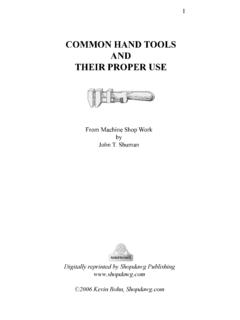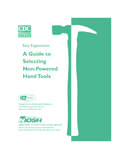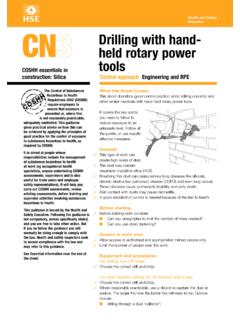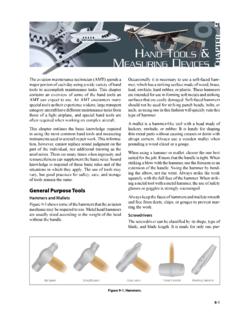Transcription of WHO Guidelines on Hand Hygiene in Health Care: a …
1 WHO Guidelines on Hand Hygiene in Health Care: a Summary First Global Patient Safety Challenge Clean Care is Safer Care a WHO Guidelines on Hand Hygiene in Health Care: a Summary World Health Organization 2009. WHO/IER/ All rights reserved. Publications of the World Health Organization can be obtained from WHO Press, World Health Organization, 20 Avenue Appia, 1211 Geneva 27, Switzerland (tel.: +41 22 791 3264; fax: +41 22 791 4857;. e-mail: Requests for permission to reproduce or translate WHO publications whether for sale or for noncommercial distribution should be addressed to WHO. Press, at the above address (fax: +41 22 791 4806; e-mail: The designations employed and the presentation of the material in this publication do not imply the expression of any opinion whatsoever on the part of the World Health Organization concerning the legal status of any country, territory, city or area or of its authorities, or concerning the delimitation of its frontiers or boundaries.))
2 Dotted lines on maps represent approximate border lines for which there may not yet be full agreement. The mention of specific companies or of certain manufacturers'. products does not imply that they are endorsed or recommended by the World Health Organization in preference to others of a similar nature that are not mentioned. Errors and omissions excepted, the names of proprietary products are distinguished by initial capital letters. All reasonable precautions have been taken by the World Health Organization to verify the information contained in this publication. However, the published material is being distributed without warranty of any kind, either expressed or implied.
3 The responsibility for the interpretation and use of the material lies with the reader. In no event shall the World Health Organization be liable for damages arising from its use. WHO Guidelines on Hand Hygiene in Health Care: a Summary First Global Patient Safety Challenge Clean Care is Safer Care WHO PATIENT SAFETY. WHO Guidelines on Hand Hygiene in Health Care: a Summary Foreword Health care-associated infections affect hundreds of millions of patients worldwide every year. Infections lead to more serious illness, prolong hospital stays, induce long-term disabilities, add high costs to patients and their families, contribute to a massive, additional financial burden on the Health -care system and, critically, often result in tragic loss of life.
4 By their very nature, infections are caused by many different sustainability of all actions for the long term benefit of everyone. factors related to systems and processes of care provision as While system change is a requirement in most places, well as to human behaviour that is conditioned by education, sustained change in human behaviour is even more important political and economic constraints on systems and countries, and relies on essential peer and political support. and often on societal norms and beliefs. Most infections, however, are preventable. Clean Care is Safer Care is not a choice but a basic right. Clean hands prevent patient suffering and save lives.
5 Thank Hand Hygiene is the primary measure to reduce infections. you for committing to the Challenge and thereby contributing A simple action, perhaps, but the lack of compliance among to safer patient care. Health -care providers is problematic worldwide. On the basis of research into the aspects influencing hand Hygiene compliance and best promotional strategies, new approaches have proven Professor Didier Pittet, effective. A range of strategies for hand Hygiene promotion Director, Infection Control Programme and improvement have been proposed, and the WHO First University of Geneva Hospitals and Faculty of Medicine, Global Patient Safety Challenge, Clean Care is Safer Care , Switzerland is focusing part of its attention on improving hand Hygiene Lead, First Global Patient Safety Challenge, WHO Patient standards and practices in Health care along with implementing Safety successful interventions.
6 New global Guidelines on Hand Hygiene in Health Care, developed with assistance from more than 100 renowned international experts, have been tested and given trials in different parts of the world and were launched in 2009. Testing sites ranged from modern, high-technology hospitals in developed countries to remote dispensaries in poor-resource villages. Encouraging hospitals and Health -care facilities to adopt these Guidelines , including the My 5 Moments for Hand Hygiene approach, will contribute to a greater awareness and understanding of the importance of hand Hygiene . Our vision for the next decade is to encourage this awareness and to advocate the need for improved compliance and sustainability in all countries of the world.
7 Countries are invited to adopt the Challenge in their own Health -care systems to involve and engage patients and service users as well as Health -care providers in improvement strategies. Together we can work towards ensuring the WHO PATIENT SAFETY. CONTENTS. INTRODUCTION V. PART I. Health CARE-ASSOCIATED INFECTION AND EVIDENCE OF THE IMPORTANCE OF HAND Hygiene 1. 1. The problem: Health care-associated infection is a major cause of death and disability worldwide 2. Magnitude of Health care-associated infection burden Health care-associated infection in developed countries Health care-associated infection in developing countries Health care-associated infection among Health -care workers 2.
8 The role of hand Hygiene to reduce the burden of Health care-associated infection 5. Transmission of Health care-associated pathogens through hands Hand Hygiene compliance among Health -care workers Strategies to improve hand Hygiene compliance Impact of hand Hygiene promotion on Health care-associated infection Cost-effectiveness of hand Hygiene promotion PART II. CONSENSUS RECOMMENDATIONS 11. Consensus recommendations and ranking system 1. Indications for hand Hygiene 12. 2. Hand Hygiene technique 15. 3. Recommendations for surgical hand preparation 15. 4. Selection and handling of hand Hygiene agents 16. 5. Skin care 16. 6. Use of gloves 17. 7.
9 Other aspects of hand Hygiene 17. 8. Educational and motivational programmes for Health -care workers 17. 9. Governmental and institutional responsibilities 18. For Health -care administrators For national governments PART III. GUIDELINE IMPLEMENTATION 25. 1. Implementation strategy and tools 26. 2. Infrastructures required for optimal hand Hygiene 28. 3. Other issues related to hand Hygiene , in particular the use of an alcohol-based handrub 28. Methods and selection of products for performing hand Hygiene Skin reactions related to hand Hygiene Adverse events related to the use of alcohol-based handrubs Alcohol-based handrubs and C. difficile and other non-susceptible pathogens REFERENCES 32.
10 APPENDICES 43. 1. Definition of terms 44. 2. Table of contents of the WHO Guidelines on Hand Hygiene in Health Care 2009 46. 3. Hand Hygiene Implementation Toolkit 49. ACKNOWLEDGEMENTS 50. WHO PATIENT SAFETY. INTRODUCTION. Confronted with the important issue of patient safety, in 2002 the Fifty-fifth World Health Assembly adopted a resolution urging countries to pay the closest possible attention to the problem and to strengthen safety and monitoring systems. In May 2004, the Fifty-seventh World Health Assembly approved the creation of an international alliance as a global initiative to improve patient safety. The World Alliance for Patient Safety was launched in October 2004 and currently has its place in the WHO Patient Safety programme included in the Information, Evidence and Research Cluster.
















